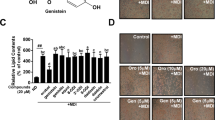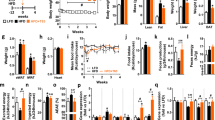Abstract
Objective:
To investigate the mechanisms underlying the antiobesity effects of a novel isoflavone-free peptide mixture (BSP) derived from black soybean.
Design:
Long-term effects of BSP were evaluated in diet-induced obese (DIO) mice fed a high-fat (HF) diet without or with BSP (2, 5 or 10% of energy) for 13 weeks, or for 8 weeks in combination with exercise. Acute effects of BSP on food intake and body weight in rats and leptin-deficient ob/ob mice were evaluated. Cell culture models or tissue extracts were used to investigate the mechanisms underlying the antiobesity effect.
Measurement:
Total food intake, body weight gain, white adipose tissue (WAT) mass, plasma concentrations of leptin, adiponectin, cholesterol and triglyceride were measured. Janus kinase 2 (JAK2)-dependent signal transducers and activators of the transcription 3 (STAT3) phosphorylation and AMP-activated protein kinase (AMPK) activity were determined using Western-blot in cultured cells or tissue extracts.
Results:
DIO mice fed an HF diet with BSP (2, 5 or 10%) for 13 weeks gained less body weight (21.4, 19.8 or 17.1 g, respectively) than the mice fed an HF diet without BSP (22.6 g) concurrent with inhibition of total food intake in a dose-dependent manner. BSP also significantly decreased food intake in rats and leptin-deficient ob/ob mice. The highest dose of BSP (10%) significantly elevated the plasma adiponectin and decreased plasma triglyceride. BSP activated JAK2-dependent STAT3 in a cell model, and elevated the level of hypothalamic phospho-STAT3 in ob/ob mice. BSP also phosphorylated AMPK and acetyl-CoA carboxylase of C2C12 myocytes in a dose-dependent manner. The antiobesity effect was augmented by low-intensity wheel-based exercise. In exercised mice, BSP significantly decreased periepididymal WAT mass and body weight gain.
Conclusion:
These results provided evidences that BSP decreased appetite and HF diet-induced body weight gain particularly in combination with exercise, through leptin-like STAT3 phosphorylation and AMPK activation.
This is a preview of subscription content, access via your institution
Access options
Subscribe to this journal
Receive 12 print issues and online access
$259.00 per year
only $21.58 per issue
Buy this article
- Purchase on Springer Link
- Instant access to full article PDF
Prices may be subject to local taxes which are calculated during checkout






Similar content being viewed by others
References
Flegal KM, Carroll MD, Ogden CL, Johnson CL . Prevalence and trends in obesity among US adults, 1999–2000. JAMA 2002; 288: 1723–1727.
World Health Organization. Global Strategy on Diet, Physical Activity and Health: Obesity and Overweight 2004;, http://www.who.int/hpr/NPH/docs/gs-obesity.pdf.
Cooke D, Bloom S . The obesity pipeline: current strategies in the development of anti-obesity drugs. Nat Rev Drug Discov 2006; 5: 919–931.
Ioannides-Demos LL, Proietto J, Tonkin AM, McNeil JJ . Safety of drug therapies used for weight loss and treatment of obesity. Drug Saf 2006; 29: 277–302.
Anderson JW, Johnstone BM, Cook-Newell ME . Meta-analysis of the effects of soy protein intake on serum lipids. N Eng J Med 1995; 333: 276–282.
Bhathena SJ, Velasquez MT . Beneficial role of dietary phytoestrogens in obesity and diabetes. Am J Clin Nutr 2002; 76: 1191–1201.
Nishi T, Hara H, Asano K, Tomita F . The soybean β-conglycinin β 51–63 fragment suppresses appetite by stimulating cholecystokinin release in rats. J Nutr 2003; 133: 2537–2542.
Duranti M, Lovati MR, Dani V, Barbiroli A, Scarafoni A, Castiglioni S et al. The α' subunit from soybean 7S globulin lowers plasma lipids and upregulates liver β-VLDL receptors in rats fed a hypercholesterolemic diet. J Nutr 2004; 134: 1334–1339.
Trujillo J, Ramirez V, Perez J, Torre-Villalvazo I, Torres N, Tovar AR et al. Renal protection by a soy diet in obese Zucker rats is associated with restoration of nitric oxide generation. Am J Physiol Renal Physiol 2005; 288: F108–F116.
Reynolds K, Chin A, Lees KA, Nguyen A, Bujnowski D, He J . A meta-analysis of the effect of soy protein supplementation on serum lipids. Am J Cardiol 2006; 98: 633–640.
Sacks FM, Lichtenstein A, Van Horn L, Harris W, Kris-Etherton P, Winston M . Soy protein, isoflavones, and cardiovascular health: a summary of a statement for professionals from the American Heart Association Nutrition Committee. Arterioscler Thromb Vasc Biol 2006; 26: 1689–1692.
Wang H-J, Murphy PA . Isoflavone content in commercial soybean foods. J Agric Food Chem 1994; 42: 1666–1673.
Erdman Jr JW, Badger TM, Lampe JW, Setchell KD, Messina M . Not all soy products are created equal: caution needed in interpretation of research results. J Nut 2004; 134: 1229S–1233S.
Lucas EA, Khalil DA, Daggy BP, Arjmandi BH . Ethanol-extracted soy protein isolates does not modulate serum cholesterol in golden Syrian hamsters: a model of postmenopausal hypercholesterolemia. J Nutr 2001; 131: 211–214.
Song T, Lee SO, Murphy PA, Hendrich S . Soy protein with or without isoflavones, soy germ and soy germ extract, and daidzein lessen plasma cholesterol levels in golden Syrian hamsters. Exp Biol Med 2003; 228: 1063–1068.
Banz WJ, Davis J, Peterson R, Iqbal MJ . Gene expression and adiposity are modified by soy protein in male Zucker diabetic fatty rats. Obes Res 2004; 12: 1907–1913.
Ni W, Tsuda Y, Sakono M, Imaizumi K . Dietary soy protein isolate, compared with casein, reduces atherosclerotic lesion area in apolipoprotein E-deficient mice. J Nutr 1998; 128: 1884–1889.
Aoyama T, Fukui K, Nakamori T, Hahimoto Y, Yamamoto T, Takamatsu K et al. Effect of soy and milk whey protein isolates and their hydrolysates on weight reduction in genetically obese mice. Biosci Biotechnol Biochem 2000; 64: 2594–2600.
Hermansen K, Hansen B, Jacobsen R, Clausen P, Dalgaard M, Dinesen B et al. Effects of soy supplementation on blood lipids and arterial function in hypercholesterolaemic subjects. Eur J Clin Nutr 2005; 59: 843–850.
Kohno M, Hirotsuka M, Kito M, Matsuzawa Y . Decreases in serum triacylglycerol and visceral fat mediated by dietary soybean beta-conglycinin. J Atheroscler Thromb 2006; 13: 247–255.
Song MK, Rosenthal MJ, Song AM, Yang H, Ao Y, Yamaguchi DT . Raw vegetable food containing high cyclo (his-pro) improved insulin sensitivity and body weight control. Metabolism 2005; 54: 1480–1489.
Bjorbaek C, Kahn BB . Leptin signaling in the central nervous system and the periphery. Recent Prog Horm Res 2004; 59: 305–331.
Kim MS, Lee KU . Role of hypothalamic 5′-AMP-activated protein kinase in the regulation of food intake and energy homeostasis. J Mol Med 2005; 83: 514–520.
Herman MA, Kahn BB . Glucose transport and sensing in the maintenance of glucose homeostasis and metabolic harmony. J Clin Invest 2006; 116: 1767–1775.
Rho SJ, Park S, Ahn CW, Shin JK, Lee HG . Dietetic and hypocholesterolemic action of black soy peptides in dietary obese rats. J Sci Food Agric 2007; 87: 908–913.
Jang EH, Park CS, Lee SK, Pie JE, Kang JH . Excessive nitric oxide attenuates leptin-mediated signal transducer and activator of transcription 3 activation. Life Sci 2007; 80: 609–617.
Lu J, Park CS, Lee SK, Shin DW, Kang JH . Leptin inhibits 1-methyl-4-phenylpyridium-induced cell death in SH-SY5Y cells. Neurosci Lett 2006; 407: 240–243.
Ishihara K, Matsumoto K, Uohashi R, Fushiki T . Effect of soybean peptide on suppression of body fat accumulation during endurance swimming in mice. Nutr Sci Soy Protein 1996; 17: 94–97.
Morifuji M, Sanbongi C, Sugiura K . Dietary soya protein intake and exercise training have an additive effect on skeletal muscle fatty acid oxidation enzyme activities and mRNA levels in rats. Br J Nutr 2006; 96: 469–475.
Yamauchi T, Kamon J, Minokoshi Y, Ito Y, Waki H, Uchida S et al. Adiponectin stimulates glucose utilization and fatty-acid oxidation by activating AMP-activated protein kinase. Nat Med 2002; 8: 1288–1295.
Carling D . The AMP-activated protein kinase cascade: a unifying system for energy control. Trends Biochem Sci 2004; 29: 18–24.
Yoon MJ, Lee GY, Chung JJ, Ahn YH, Hong SH, Kim JB . Adiponectin increases fatty oxidation in skeletal muscle cells by sequential activation of AMP-activated protein kinase, p38 mitogen-activated protein kinase, and peroxisome proliferator-activated receptor α. Diabetes 2006; 55: 2562–2570.
Park KS, Kim HM, Kim JO, Lee JH . Suppression of mammary tumorigenesis by soy peptide. The Korean Society of Food Science and Nutrition, Annual Meeting and International Symposium 2004; S2-1: 71–72.
Bates SH, Myers Jr MG . The role of leptin receptor signaling in feeding and neuroendocrine function. Trends Endocrinol Metab 2003; 14: 447–452.
Spiegelman BM, Flier JS . Obesity and the regulation of energy balance. Cell 2001; 104: 531–543.
Yamauchi T, Kamon J, Ito Y, Tsuchida A, Yokomizo T, Kita S et al. Cloning of adiponectin receptors that mediate antidiabetic metabolic effects. Nature 2003; 423: 762–769.
Setchell KDR . Phytoestrogens: the biochemistry, physiology, and implications for human health of soy isoflavones. Am J Clin Nutr 1998; 68: 1333S–1346S.
Tham DM, Gardner CD, Haskell WL . Potential health benefits of dietary phytoestrogens: a review of the clinical, epidemiological, and mechanistric evidence. J Clin Endocrinol Metab 1998; 83: 2223–2235.
Setchell KDR, Cassidy A . Dietary isoflavones: biological effects and relevance to human health. J Nutr 1999; 129: 758S–767S.
Penza M, Montani C, Romani A, Vignolini P, Pampaloni B, Tanini A et al. Genistein affects adipose tissue deposition in a dose-dependent and gender-specific manner. Endocrinology 2006; 147: 5740–5751.
Stark A, Madar Z . Phytoesterogens: a review of recent findings. J Pediatr Endocrinol Metab 2002; 15: 561–572.
Cassidy A . Potential risks and benefits of phytoestrogen-rich diets. Int J Vitam Nutr Res 2003; 73: 120–126.
Acknowledgements
This work was supported by Nongshim Co., Ltd, Seoul, South Korea.
Author information
Authors and Affiliations
Corresponding author
Additional information
Supplementary Information accompanies the paper on International Journal of Obesity website (http://www.nature.com/ijo)
Supplementary information
Rights and permissions
About this article
Cite this article
Jang, EH., Moon, JS., Ko, J. et al. Novel black soy peptides with antiobesity effects: activation of leptin-like signaling and AMP-activated protein kinase. Int J Obes 32, 1161–1170 (2008). https://doi.org/10.1038/ijo.2008.60
Received:
Revised:
Accepted:
Published:
Issue Date:
DOI: https://doi.org/10.1038/ijo.2008.60
Keywords
This article is cited by
-
Effects of black soy peptide supplementation on blood pressure and oxidative stress: a randomized controlled trial
Hypertension Research (2013)



